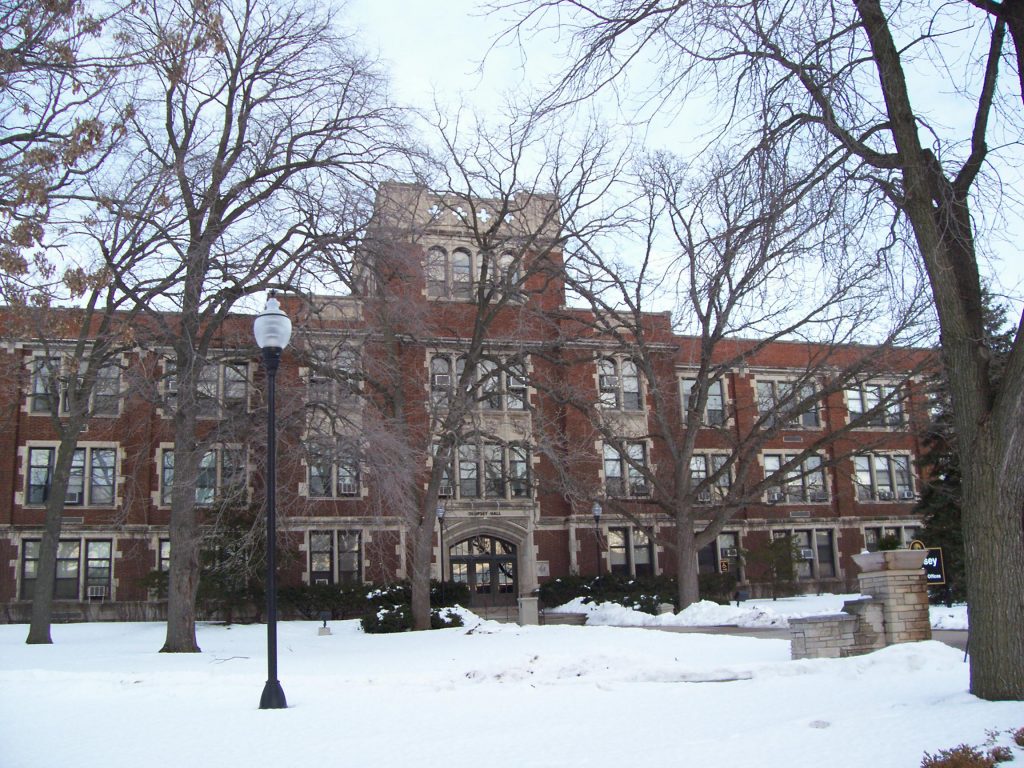UW Campuses Face Challenging Financial Futures, Reports Show
Wisconsin's funding for public universities ranks 42nd in the nation.

Dempsey Hall the administration building at the U.W.-Oshkosh. Photo by Royalbroil, (CC BY-SA 4.0), via Wikimedia Commons
University of Wisconsin schools are facing challenging financial futures without major changes, according to recent campus financial reports.
Several factors have led to campuses’ financial difficulties including declining state support on an inflation-adjusted basis over the last decade, the impacts of the decade-long tuition freeze that ended in 2022, declining enrollment and inflation.
The UW system employed Deloitte as a third-party consultant to conduct financial assessments of the individual campuses. Universities of Wisconsin President Jay Rothman said in a statement that the assessments are part of the work being done to help eliminate structural deficits throughout the system by 2028, and ensure the state’s campuses are financially viable and durable. However, he also said that additional investment from the state of Wisconsin is needed to ensure the system’s future success.
Reports for seven campuses — including UW-Green Bay, UW-Oshkosh, UW-Parkside, UW-Platteville, UW-River Falls, UW-Superior and UW-Whitewater — were released on Thursday.
Rothman noted that several campuses are already in the process of making decisions to get schools on a healthier financial track. Those decisions have come in the form of voluntary buyouts, layoffs and furloughs at UW-Parkside, UW-Oshkosh, UW-Platteville. UW-Green Bay has considered eliminating several majors and minors.
However, some of the reports noted that further changes at the campuses are likely necessary. For example, UW-Green Bay’s report warned that campus leadership should “act with urgency to steer the University on a path of financial sustainability.”
“Green Bay has recognized these challenges and made budget reductions; however, absent further changes to the status quo, the university will struggle to resolve its deficit as the state participation rate declines and the traditional college applicant pool in Wisconsin shrinks; these trends could result in depletion of the tuition fund balance by FY27,” the report stated.
UW-Oshkosh’s report noted that the school has implemented a plan that uses furloughs, voluntary retirement incentives, layoffs, elimination of open positions and academic workload adjustments to address its structural deficit, but additional savings will be needed for fiscal year 2025 and beyond. It said that “fresh approaches to student recruitment and retention are needed to help secure a viable future” for the school, and its academic portfolio may need refinement and it could consider being more transfer-friendly.
University administrators said there were certain themes in the opportunities that will be available to schools including improving student retention, leveraging schools’ core strengths, implementing direct admissions and expanding dual enrollment and continuing education programs.
However, Rothman acknowledged that funding from the state of Wisconsin will play a deciding role in the system’s financial future, and the type of education that can be afforded across the state.
“While we will do our part on the expense side of the ledger, ultimately it is up to the state to decide whether it wants and can afford a weakened Universities of Wisconsin. The adage is that you get what you pay for,” Rothman said. He noted Wisconsin’s current funding for its public universities ranks 42nd in the country.
Rothman said that level of funding “will eventually get you a 42nd ranked university system. Wisconsin deserves better than that.”
It would take about $440 million to bring the state to the median level of funding.
Gov. Tony Evers said in a statement that the reports are the result of Republican lawmakers’ inadequate funding to Wisconsin’s public university campuses, and that he would be requesting additional funding in the next budget cycle.
“Republican lawmakers have spent more than a decade waging war on public education in Wisconsin, including our UW System and higher education institutions,” Evers said, “and have consistently refused to make the necessary, meaningful investments our state and our campuses desperately need to compete and that our students deserve.”
Evers committed to asking for additional funding from the state Legislature in the next budget cycle. In the latest state budget, UW schools didn’t receive a funding increase from the Legislature.
“The Legislature must step up, and that’s what I’ll be asking them to do once again in my next proposed budget,” Evers said.
Reports for the state’s remaining campuses and Universities of Wisconsin Administration — excluding UW-Madison, which doesn’t have a structural deficit and carries a healthy reserve — will be prepared in the summer and fall.
Wisconsin public universities face challenging financial futures, according to reports was originally published by Wisconsin Examiner.





















Probably a good time to start winding down some of these universitys as the level of education at most of these schools is not very good or relavant in todays business climate. Most of of us learned little to nothing in college while spending tens of thousands of dollars(and I graduated uw-madison) it seems like a good time to break away from this incredibly outdated vestage of the past.
History is important in understanding the importance of this story. Some 65 years ago, I graduated – barely – from high school. The first in my family of grade-school educated immigrant parents from Yugoslavia. At that point, I had three choices: being drafted into the army, going to work at my dad’s American Motors plant, or, least likely, going to college.
The first two options didn’t seem too appealing to me, and my bottom-of-the barrel high-school grades narrowed my college options. Narrowed pretty much to UW-M, which had “open admissions.” If you graduated from high-school, whatever your grades, you got in.
Then, there was the tuition, $80 per semester (about $1,600 per year in current dollars), and buy your books at Mike Green’s Used Book Store. Even with zero family support, that price was easily manageable for me, and for lots of other working-class kids.
At that time, I believe that State support accounted for approximately 90% of the university’s budget, eliminating the tuition barrier for kids from low-income families with no history of college attendance. Flash forward to today: with state support down to something like 20%, it is almost $10,000/year.
It is a 100% certainty that, had these current tuition levels prevailed in 1959, I would have never gone to college. And would have never had the life-changing experience that a UW-M education was for me. And for many others like me.
The focus on budget cuts, the transformation of the university into a corporate training center and current costs for attending students leaves out something very big: all of those kids like me, who, in this environment, will never go to college because of the daunting costs. A huge personal loss, a loss to society, and further reinforcement of our world-class inequality.